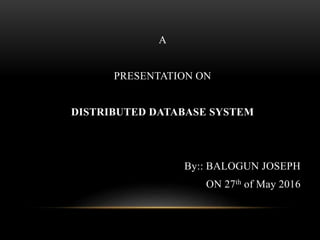
Csc 303
- 1. A PRESENTATION ON DISTRIBUTED DATABASE SYSTEM By:: BALOGUN JOSEPH ON 27th of May 2016
- 2. DISTRIBUTED DATABASE SYSTEM • A distributed database (DDB) is a collection of multiple, logically interrelated databases distributed over a computer network • A distributed database management system (DDBMS) is the software that manages the DDB and provides an access mechanism that makes this distribution transparent to the users. Note however that the terms are most times, used interchangeably
- 3. CONT’D • Distributed database design defines the optimum allocation strategy for database fragments in order to ensure database integrity, security, and performance. The allocation strategy determines how to partition the database and where to store each fragment.
- 4. CONT’D • A database may need to be distributed among multiple geographically disperse locations. Processes that access the database may also vary from one location to another. Resources that can be distributed includes but not limited to: • Functions • Processes • Data • Control
- 5. CONT’D • For example, a retail process and a warehouse storage process are likely to be found in different physical locations. If the database data and processes are to be distributed across the system, portions of a database, known as database fragments, may reside in several physical locations. A database fragment is a subset of a database that is stored at a given location. The database fragment may be composed of a subset of rows or columns from one or multiple tables.
- 6. DATABASE SOFTWARE SELECTION • The selection of DBMS software is critical to the information system’s smooth operation. To avoid false expectations, • the end user must be made aware of the limitations of both the DBMS and the database. The followings are factors that should be considered while purchasing a DBMS and Database Application:
- 7. DATABASE SOFTWARE SELECTION CONT’D • Cost. This includes the original purchase price, along with maintenance, operational, license, installation, training, and conversion costs. • DBMS features and tools. Some database software includes a variety of tools that facilitate the application development task. For example, the availability of query by example (QBE), screen painters, report generators, application generators, data dictionaries, and so on, helps to create a more pleasant work environment for both the end user and the application programmer. Database administrator facilities, query facilities, ease of use, performance, security, concurrency control, transaction processing, and third- party support also influence DBMS software selection.
- 8. DATABASE SOFTWARE SELECTION CONT’D • Underlying model. This can be hierarchical, network, relational, object/relational, or object- oriented. The most suitable and relevant model should be considered. • Portability. A DBMS can be portable/deployed across platforms, systems, and languages. In other words, a good DBMS and Database Application should be platform independent. High portability will be considered. • DBMS hardware requirements. Items to consider include processor(s), RAM, disk space, and so on.
- 9. DATABASE DESIGN STRATEGY • There are two classical approaches to database design: • Top-down design: In this design approach, the entities are first identified and then their data items (fields/attributes) are then defined. In other words, this strategy starts by identifying the data sets and then defines the data elements for each of those sets. This process involves the identification of different entity types and the definition of each entity’s attributes.
- 10. DATABASE DESIGN STRATEGY CONT’D • Bottom-up design: In this design approach, the data items (fields/attributes) are first identified and then classify them according to the associated entity. In other words, this approach first identifies the data elements (items) and then groups them together in data sets. Simply put, it first defines attributes, and then groups them to form entities.
- 11. Top Down: From Entity down (Top DOWN ↓) to the Attributes Bottom Up: From Attributes up (Bottom-UP ↑) to the Entity
- 12. CENTRALIZED AND DECENTRALIZED DESIGNS • Aside the general design approaches (top-down and bottom-up), design approach can also be dependent upon the organizational style or structure. With respect to this, database design strategy can be seen from two perspectives, viz: Centralized and Decentralized Designs.
- 13. CENTRALIZED DESIGN • This is considered when the design in view is relatively small in size and such that it can be handled by a single individual. Centralized design is considered most suitable when the database design is of relatively small volume and in which the task can be handled by a single designer (database administrator) or by a small, informal design team. The company operations and the scope of the problem are sufficiently limited to allow even a single designer to define the problem(s), create the conceptual design, verify the conceptual design with the user views, define system processes and data constraints to ensure the efficacy of the design, and ensure that the design will comply with all the requirements.
- 15. DECENTRALIZED DESIGN • This is the direct opposite of centralized design. This might be used when the data component of the system has a considerable large number of entities and complex relations on which very complex operations are performed. Decentralized design is also likely to be employed when the problem itself is spread across several operational sites and each element is a subset of the entire data set. • In large and complex projects, the database design typically cannot be done by only one person. Instead, a carefully selected team of database designers is employed to tackle a complex database project. Within the decentralized design framework, the database design task is divided into several modules. Once the design criteria have been established, the lead designer assigns design subsets or modules to design groups within the team.
- 17. THANK YOU